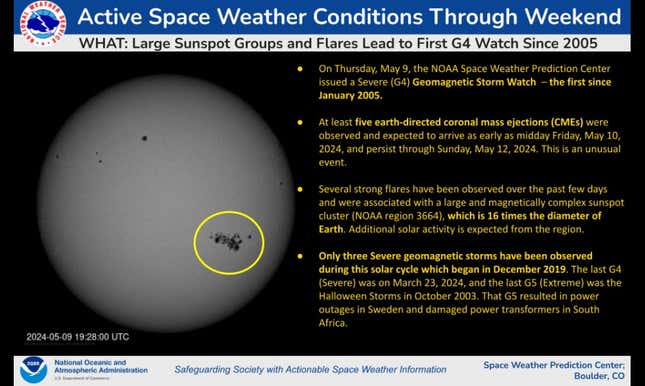World Warned To Prepare For Today’s Severe Geomagnetic Storm, First In 20 Years
The National Oceanic and Atmospheric Administration’s Space Weather Prediction Center forecasted a “severe solar storm” that’s expected to hit Earth tonight, according to a release. These geomagnetic storms happen every so often, but as the Sun approaches the maximum of its 11-year solar cycle, the space weather is getting more intense.
A geomagnetic storm occurs when solar flares and coronal mass ejections (CMEs) occur on the Sun, causing variation in the solar wind that hits Earth’s magnetosphere, the protective sheath of Earth’s magnetic field.
Related article: How Scientists Are Prepping for the Incoming Severe Solar Storm
At best, the storms cause mesmerizing—but harmless—auroras, as charged particles from the Sun collide with the particles that make up Earth’s atmosphere along its magnetic poles, emitting visible light. But at worst, the storms can disrupt Earth-based navigation systems like GPS and trigger disruptions to infrastructure like the power grid and radio and satellite communications.
Advertisement

The coming storm was given a Severe (G4) rating by the Space Weather Prediction Center and prompted a Geomagnetic Storm Watch, the first time since January 2005 such an alert has been issued. The center anticipates at least five CMEs that will be directed at Earth between midday today, May 10, and Sunday, May 12. The Sun produced a strong solar flare on Thursday, specifically an X1.1 flare; “X-class denotes the most intense flares, while the number provides more information about its strength,” according to NASA. Earlier in the day, NOAA documented an even stronger solar flare, classified as a strong X2.2 flare.
Advertisement
Experts from NOAA’s Space Weather Prediction Center will give a press conference discussing the storm and its potential impacts today at 10 a.m. ET. We will update this story with details from that press conference once it occurs.
According to a NOAA graphic, several recent flares on the Sun in the past week are associated with a large sunspot cluster about 16 times as wide as Earth. You can actually look at this sunspot yourself using eclipse glasses, if you have a pair lying around (just make sure they’re safe for use!)
Advertisement
Since the ongoing solar cycle began in December 2019, NOAA has only observed three Severe geomagnetic storms, the most recent (also a G4 rating) occurring in March 2024. The last G5 geomagnetic storm—a more severe tier—occurred in October 2003 and caused power outages in Scandinavia and damaged infrastructure as far south as South Africa, according to the same graphic.
The Sun’s intensity rises and falls over a 11-year cycle, meaning the current solar cycle won’t be complete until 2030. As Gizmodo reported in 2022, our somewhat-unpredictable star is a real problem for satellite operators, whose off-Earth infrastructure is particularly exposed to solar fluctuations. We’ll learn more about the impacts of the ongoing solar event soon, but here’s hoping we get some lovely auroras without any of the infrastructural chaos.
Advertisement
More: When Will There Be a New Solar Superstorm?
READ MORE HERE



